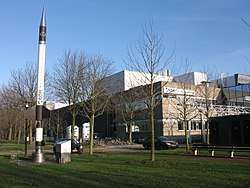Netherlands Institute for Space Research
SRON Netherlands Institute for Space Research is the Dutch expertise institute for space research. The Institute develops and uses innovative technology for research in space, focusing on astrophysical research, Earth science and planetary research. SRON has a line of research into new and more sensitive sensors for X-rays and infrared radiation.
Ruimteonderzoeksinstituut SRON | |
| Agency overview | |
|---|---|
| Abbreviation | SRON |
| Formed | 1983 |
| Type | Space agency |
| Headquarters | Utrecht |
| Administrator | Michael Wise (Scientific Director) |
| Employees | 200 |
| Website | www.sron.nl |

SRON was founded in 1983 under the former names Stichting Ruimteonderzoek Nederland / Space Research Organisation Netherlands. SRON is part of the Netherlands Organisation for Scientific Research (NWO) and has facilities in Utrecht and in Groningen.
Science and technology
The institute has over 250 staff who are employed at a support department and five divisions: High-Energy Astrophysics (HEA), Low-Energy Astrophysics (LEA), Earth and Planetary Science (EPS), Sensor Research and Technology (SR&T) and Engineering Division (ED).
Technology
SRON's ambition is to act as leading institute in the development of state-of-the-art satellite instruments for space research missions of ESA, NASA and other agencies. Through the years SRON technology has contributed to many ground-breaking space missions, mainly dedicated to mapping the infrared sky (e.g. IRAS, ISO, HIFI/Herschel), analyzing X-ray and gamma ray sources (e.g. CGRO/COMPTEL, Beppo-SAX, Chandra, XMM-Newton) and studying the Earth atmosphere (SCIAMACHY/ENVISAT). Examples of future missions to which SRON will contribute are SPICA (infrared), ASTRO-H (X-ray) and Sentinel 5 Precursor (Earth atmosphere). The institute is also planning contributions to missions which will study other planets in the Solar System and beyond.
Missions and projects
Current missions or projects with SRON contribution
SRON instruments are in brackets.
- Athena (X-IFU)
- Chandra (Low Energy Transmission Grating Spectrometer (LETG))
- XMM-Newton (Reflection Grating Spectrometers (RGS))
- INTEGRAL
- XRISM (Resolve Soft X-Ray Spectrometer)
- LOFT
- SPICA (SAFARI)
- ALMA (2 band receivers)
- Sentinel-5p (TROPOMI)
- Sentinel 5 (Immersed gratings)
- MetOp (GOME-2)
- GUSTO
- ARIEL
- PLATO
- PACE (SPEXone)
Technology development

In various wavelength areas SRON's sensors are already some of the most sensitive in the world. However, SRON is continuously looking for new ways to deploy even more sensitive sensors for the improved detection of cosmic radiation or for measurements of the atmosphere of the Earth and other planets. This requires long-term investments in the development of new sensors, electronics and specialist techniques. In the near future detectors shall increasingly take the shape of large chips with many megapixels, with a unique combination of two dimensional pictures and spectroscopy color resolving power.
These detectors require the development of new advanced electronics, smart control software, extreme cooling techniques and novel materials. SRON develops a new generation of detectors, and the necessary read-out and control electronics, for international missions in the submillimeter and far-infrared areas. For example, such extremely sensitive detectors are needed in SPICA/ SAFARI so that we can learn more about protoplanetary discs and the formation of planets. For SPICA/ SAFARI SRON is currently working on Transition Edge Sensors (TES).
National and international partners
Customers are on the one hand the international organizations with which SRON cooperates in bilateral, European or global projects. On the other hand, there is science as the customer: scientists from the Universities in Utrecht, Groningen and Leiden, and outside the Dutch borders for example with DLR.
Directors
- Johan Bleeker (1983–2003)[1]
- Karel Wakker (2003–2009)[2]
- Roel Gathier (2009–2010) (interim)[2]
- Rens Waters (2010–2019)[3]
- Michael Wise (2019-...)
See also
| Wikimedia Commons has media related to Astronomische Nederlandse Satelliet. |
References
- "Johan Bleeker (1942): Pionier en koersbepaler van het ruimteonderzoek" (in Dutch). Netherlands Institute for Space Research. Retrieved 26 June 2016.
- "Algemeen directeur Karel Wakker verlaat SRON" (in Dutch). Netherlands Institute for Space Research. 30 January 2009. Retrieved 26 June 2016.
- "New directorate at space research institute SRON". Netherlands Institute for Space Research. 21 June 2010. Retrieved 26 June 2016.
External links
- Official website SRON